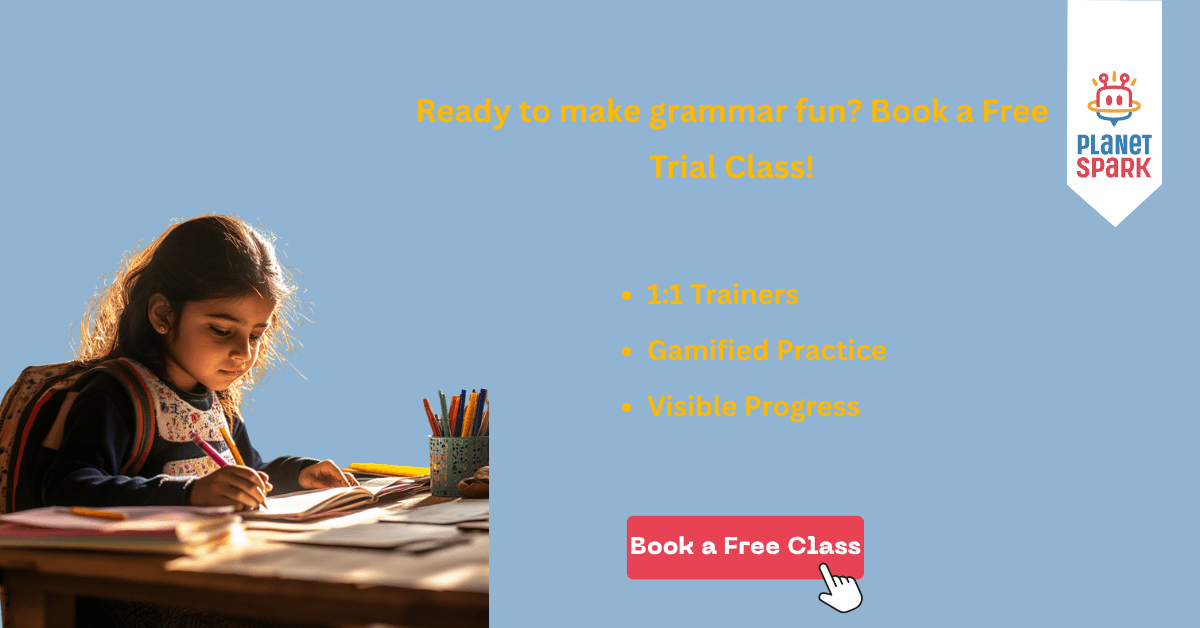English Grammar Verbs Class 1 – Guide with Examples

Verbs form the core of sentence construction and for young learners in Class 1, understanding verbs opens the door to expressing ideas, actions, and feelings. This guide is tailored to engage and educate children, parents, and teachers with a deep dive into what verbs are, types of verbs, how to teach and reinforce them, along with worksheets, fun games, FAQs, and a PlanetSpark pitch at the end.
By the time you reach the end of this guide, you should have:
A clear, child-friendly definition of verbs
A deep understanding of different verb types
Ready-to-use activities and games for home or classroom
Printable worksheets and practice sheets
Tips to help your child apply verbs in speaking and writing
A broader sense of how PlanetSpark can support grammar learning
What Exactly Is a Verb?
At its simplest, a verb is a word that shows action or tells us what someone or something is doing. Verbs are often called “doing words” because they show something that the person or object named in the sentence does. They are essential; without a verb, a sentence isn’t complete.
Examples of Verbs in Everyday Sentences:
I run in the park.
She eats an apple.
The baby sleeps peacefully at night.
We sing together in the morning.
He thinks before he speaks.
These examples are familiar to Class 1 students, they represent daily actions they see, hear and perform. Use real-life moments to point out verbs, and your little learners will quickly recognize and repeat them.

Why verbs matter in Class 1
Without a verb, there is no action in the sentence
Verbs add clarity, showing who did what
They are the building blocks for forming complete and understandable sentences, which leads to better speaking and writing
Types of Verbs for Class 1
Understanding verbs becomes easier when you break them into categories. Here are the main types suitable for Class 1 children:
Action Verbs
Definition: Show physical or mental actions
Examples: run, jump, play, eat, drink, sing, read, draw, sleep
These are often the first verbs kids learn since they mimic everyday activities.
Being Verbs
Definition: Show a state of being or existence
Examples: is, am, are
Usage:
I am happy
He is a student
They are my friends
Helping (Auxiliary) Verbs
Definition: Work with a main verb to show tense, mood, or aspect
Common Examples: is eating, am running, are singing
Why they matter: They help kids grasp the idea of time, whether something is happening now, was happening, or will happen
Linking Verbs
Definition: Connect the subject with more information
Examples: feels, looks
The flower looks beautiful
The soup feels hot
Though slightly advanced, they appear in elementary descriptive sentences
Summary Table:
| Verb Type | What It Shows | Simple Examples |
|---|---|---|
| Action Verbs | Actions that someone/thing does | run, jump, play, eat |
| Being Verbs | State of being or existence | is, am, are |
| Helping Verbs | Help show tense or aspect of an action | is eating, am reading |
| Linking Verbs | Connect subject to description | looks, feels |
How to Teach Verbs to Class 1 Children
Real-Life Speaking Prompts
Ask, “What are you doing?”
Encourage answers like: “I am eating,” “I am drawing,” “I am jumping.”
Action-Based Games
Simon Says: “Simon says, jump!”
Charades for Kids: Act out verbs like “sleep” or “swim”
Action Race: Place verb cards at one end. Kids run to a card, pick one, read the verb, and do it
Verb Stories
Create a story from the child's day: “This morning I woke up, brushed my teeth, ate my breakfast...”
Underline or highlight each verb
Visual Cards and Charts
Create picture cards with action images and their matching verbs. Kids read and act them out
Songs and Rhymes
Include action songs like “Head, Shoulders, Knees and Toes” or “If You're Happy and You Know It”
Sentence Building Practice
Give subjects and verb choices:
He ___ (runs/run)
They ___ (eat/eats)
Use correct answers to reinforce subject-verb agreement
Common Verbs Every Class 1 Kid Should Know
| Daily Routine | School Activities | Home Activities |
|---|---|---|
| eat | read | clean |
| drink | write | sleep |
| go | draw | cook |
| come | sing | wash |
| walk | listen | sit |
| wake | count | cry |
| play | paint | watch |
| jump | learn | help |
Encourage your child to make full sentences using these:
I eat my lunch
She reads a book
We walk to the park
Sentences and Basic Grammar Rules
Subject–Verb Agreement
Singular subjects → add “-s” to the verb
He runs
She likes apples
Plural subjects → base form of the verb
They play
We read books
Verb Placement in Sentences
Start with the subject
Add the verb
End with object or description
Example: They play football
Subject = They, Verb = play, Object = football
Simple Present Tense
For habits and routines:
I eat
You drink
He/She plays
We walk
Present Continuous (Intro)
Use: is/am/are + verb + ing
Examples:
She is dancing
I am reading
Use sparingly, but it introduces time-based actions
Fun Activities and Games to Reinforce Learning
Verb Action Game
One child calls out a verb; others perform the action
Start slow, build momentum: jump, skip, twirl, crawl
Verb Sorting Race
Cards with a mix of verbs and nouns. Kids sort into "verbs" and "non-verbs"
Fill-in-the-Blanks
I ___ (eat / eats) my lunch
She ___ (play / plays) with a ball
They ___ (throw / throws) a paper airplane
Answers: eat, plays, throw
Verb Storytime
Read aloud. Kids clap or raise hands when they hear a verb
Follow-up: list the verbs they caught
Verb Hunt
Create a word search puzzle with hidden verbs
Daily Verb Journal
Ask your child to complete:
“Today I ___, I ___, I ___”
Let them draw illustrations for each
Picture Matching
Match a picture (e.g., a dog jumping) to the right verb ("jump")
Role Play
Give action prompts like “Pretend to drive” or “Pretend to cook”
Great for imagination and real-world use
✅ Free printable worksheet to reinforce verb learning – Download now
Worksheets and Practice Sheets
Create printable or digital worksheets like:
Matching Worksheet
Match action images with the correct verb label
Circle the Verbs
Example: “The cat sleeps on the mat.” Kids circle "sleeps"
Fill-in-the-Blanks
Provide sentences with options in brackets
Label the Action
Draw or show pictures and ask kids to write the verb below
Verb Rhymes
Use simple rhyme pairs like:
I jump; I bump
I sing; I swing
Printable Daily Log
Today I ____, I ____, I ____
Great for routine writing and habit building
Integrating Verbs into Speaking and Writing
Daily Speaking Prompts
Encourage conversations that start with actions
“What did you do today?” “I ran. I painted.”
Verb Expansion
Turn one-word answers into full sentences
“Sleep.” → “I sleep.” or “I am sleeping.”
Question Prompts
Ask follow-ups like:
“What did you eat?”
“Where did you go?”
Drawing Journal
Child draws an action and writes a matching verb
Games to Stretch Learning
Verb Bingo
Make bingo sheets with verbs. Call them out; child marks when they hear them
Verb Board Game
Simple board game where kids land on pictures and say or act the verb
Verb Pictionary
One child draws a verb; the others guess the action
Memory Match
Match verb words with corresponding pictures
Verb Sorting by Phonics
Sort verbs based on beginning sounds or ending sounds
Mini Skits
Use simple scripts that include verbs
E.g., “You are cooking,” “You are jumping.”
FAQs About Teaching Verbs to Class 1 Kids
Why start learning verbs early?
Because verbs help children form complete sentences and express their thoughts clearly.
Can Class 1 students handle multiple verb types?
Yes. Begin with action verbs and slowly introduce being and helping verbs in context.
How do I ensure my child uses verbs correctly?
Practice speaking in full sentences and reinforce subject-verb agreement.
What’s the rule for adding ‘s’ to verbs?
Add “-s” for singular third-person subjects (he, she, it). Don’t use “-s” for I, you, we, they.
Should we teach past tense too?
Introduce gently with familiar examples:
Today I eat → Yesterday I ate
Avoid complex tenses for now
How PlanetSpark Makes Grammar Fun
PlanetSpark brings grammar alive with its structured yet exciting online platform.
Why parents trust PlanetSpark for grammar:
1:1 personal coaching
Gamified grammar sessions
Spark Diary for daily writing practice
PTMs and detailed progress reports
Interactive communities for writing, speaking, and debating
Book your child’s free trial now and watch them grasp English grammar confidently and joyfully.
Recap – Verbs at a Glance
| Verb Type | Sample Verb | Sentence Example |
|---|---|---|
| Action | jump | I jump high |
| Action | read | She reads a story |
| Being | is | He is happy |
| Helping | is eating | She is eating lunch |
| Linking | looks | The cake looks yummy |
Key Reminders:
Verbs show actions and states
Use real-life examples and games
Practice daily in speech and writing
Start simple and build confidence
Personalized Communication Report
Record a video to get a AI generated personalized communication report for your child

Hi There, want to try these
tips for your child with
LIVE with our expert coach?
Let's check your child's
English fluency
